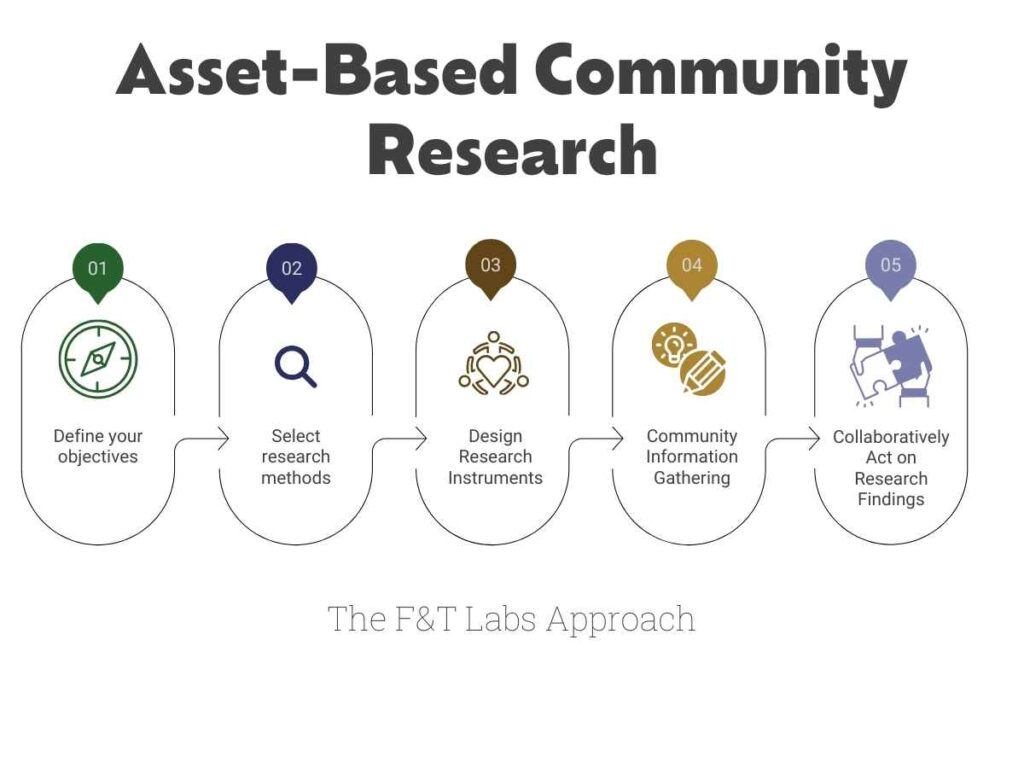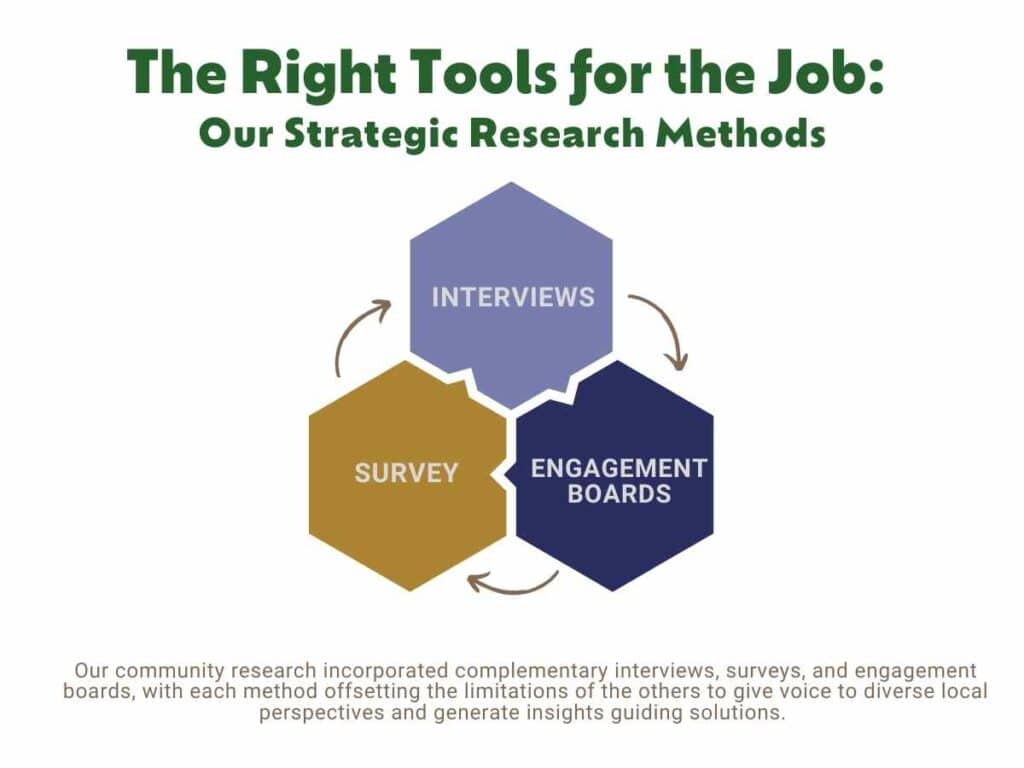Assest-based community research is listening to a community, shaping questions, and collecting data for change.
The key to meaningful community engagement lies in adopting a participatory approach that focuses on sharing power and fostering action rather than merely gathering data. This article delves into the nuances of conducting community research that upholds participants’ dignity, catalyzes systemic change, and drives actionable outcomes. At Flourish & Thrive Labs, we have developed a framework for doing community research that provides actionable insights, respects participants, and is ethical.

Introduction
Sustainable community development hinges on residents’ active participation in identifying challenges and solutions. Too often, marginalized communities become mere subjects in research projects that extract valuable local knowledge but do little to address systemic inequities. Such extractive models perpetuate a cycle where communities are studied but not empowered. Organizations genuinely committed to social equity must reimagine the role of research as a tool for amplifying marginalized voices rather than just a mechanism for data collection. The ultimate aim should be facilitating community ownership and inspiring collaborative action rather than perpetuating one-sided narratives.
Authentic community engagement is a long-term commitment that requires humility, patience, and a deep understanding of local dynamics. When done thoughtfully and respectfully, such engagement can strengthen community bonds and activate collective aspirations, leading to transformative change.

1. Define Your Objectives for Asset-Based Community Research
In community-based participatory research, the most effective strategy is to start by envisioning the desired outcome for the community. This approach, often termed ‘beginning with the end in mind,’ involves working backward from your ultimate goal to determine the most effective path forward. You can more accurately tailor your research process to meet these objectives by clearly visualizing the positive changes you aim to bring about.
Imagine the ideal scenario that your research could help achieve. Whether it’s improved educational opportunities, better healthcare access, or greater economic equality, having a clear picture of this end state guides every aspect of your research. It’s like setting a destination in a navigation system; once you know where you want to go, you can chart the most efficient and effective route to get there.
This forward-thinking mindset encourages you to consider specific changes needed to reach that goal. What does success look like in tangible terms? Is it a certain percentage increase in high school graduation rates among a minority group? Is it a measurable improvement in access to primary healthcare services in a low-income neighborhood? Defining these success metrics upfront clarifies your objectives and provides a benchmark against which to measure your progress.
With your end goal vividly outlined, you can now reverse-engineer the process to achieve it. This is where formulating impactful research questions comes into play. These questions are the tools you will use to dissect the current state of the community, understand the challenges, and identify pathways to effect the desired change. They are the stepping stones leading you from the present reality to the envisioned future.
Create Your Research Questions
Once you’ve defined your objectives for community research, the next step is crafting research questions that align with these goals. Effective research questions are the cornerstone of your project, guiding the direction of your inquiry and ensuring relevance to the community’s needs. Here are some key considerations for developing these questions:
- Relevance to Objectives: Ensure each question directly contributes to understanding and achieving your objectives. If you aim to enhance healthcare access, your questions should delve into current barriers, community health needs, and potential solutions.
- Community-Centric Approach: Involve community members in formulating these questions. Their insights can reveal critical aspects you might overlook. This collaborative approach enriches your research and fosters a sense of ownership and participation among community members.
- Clarity and Specificity: Craft questions that are clear and focused. Vague questions can lead to ambiguous results. If you’re addressing economic equality, a question like “What specific financial challenges do local small businesses face?” is more actionable than a broad query about economic conditions.
- Feasibility and Practicality: Consider your resources, time, and budget. Tailor your questions to what is realistically achievable within these constraints. Balancing ambition with practicality is essential to ensure your research is impactful and manageable.
- Ethical Considerations: Ensure your questions respect the dignity and privacy of community members. Ethical considerations should guide your inquiry, particularly when dealing with sensitive issues.
- Flexibility for Adaptation: Be prepared to refine your questions as you engage more deeply with the community and your research progresses. Adaptability is key in community-based research, as new insights and challenges can emerge.
For instance, if your objective is to improve educational outcomes for a minority group, your questions might include:
- “What educational resources are most lacking for [target group] students?”
- “How do cultural barriers affect the educational engagement of [target group] parents with the school system?”
- “What aspects encourage engagement with the school system by [target group]?”
- “What are existing systems that support [target group] in educational success?”
These questions are directly tied to your objective, considerate of community perspectives, clear, feasible, ethical, and flexible enough to evolve as you gather more information. Remember, the ultimate aim of these questions is not just to gather data but to catalyze positive change and contribute to the community’s well-being.
2. Choose Participatory Research Methods
When embarking on community research, it’s essential to adopt methods that are not only collaborative but also empowering. This approach means conducting research with people rather than on them. It involves community members at every stage: shaping research design, interpreting data, and applying findings to address real-world challenges.
Beyond traditional methods like surveys or interviews, explore innovative participatory techniques. These could include focus groups allowing in-depth discussions, community mapping exercises visually representing and analyzing local issues, or participatory photography where residents document their daily experiences. Such methods enable community members to voice their perspectives in diverse and meaningful ways.
Addressing power imbalances is crucial. Create spaces where community voices are heard but also valued and influential. This might involve training sessions for community members on research methodologies or collaborative decision-making forums to set research priorities. Transparency about your research process and findings is key to building trust and shared ownership.
Remember, even with budget and time constraints, there are creative ways to involve the community. For instance, digital platforms can facilitate virtual town halls or online surveys, offering cost-effective and time-efficient alternatives to traditional methods.
Incorporating community leadership into your research adds authenticity and ensures cultural relevance. Ethically conducted, community research transcends data collection; it becomes a form of community organizing. Empowering residents through this process can spark a transformative journey, turning research into a communal action and change catalyst.
3. Design Research Instruments for Asset-Based Community Research
In asset-based community research, the design of your research instruments — encompassing both questions and tools — plays a pivotal role. They must be crafted with a deep respect for the community, focusing not only on challenges but also on its inherent strengths and positive aspects. These instruments must encourage a comprehensive understanding of the community, reflecting its multifaceted nature.
Your questions and tools should delve into the community’s existing strengths, tapping into areas where residents are already actively involved. For instance, you might ask, “In what community activities or groups are you currently participating?” or “What local initiatives have you found most effective or inspiring?” These inquiries help identify key areas where community engagement is strong and can be further supported.
Additionally, it’s important to explore what residents view as the best aspects of their community. Questions like “What do you value most about our community?” or “What unique strengths do you think our community possesses?” can shed light on the positive elements that residents cherish. This approach brings a balance to your research by highlighting positives alongside challenges and fosters a sense of pride and ownership among community members.
In this approach, respect and inclusivity are paramount. The intent is to create a conversational space where community voices are heard and central to the narrative. This methodology enriches the data collected and reinforces the ethos of asset-based community research. This process is collaborative, empowering, and deeply respectful of the community’s narrative and aspirations.
4. Community Information Gathering (Data Collection) in Community-Based Research
In community-based research, ethical community information gathering is vital. This approach balances valuable insights with respect for individuals. It starts with informed consent, ensuring participants understand the research’s purpose and their role. This step is more than a procedural formality; it empowers individuals, especially those from marginalized backgrounds, by validating their experiences and voices.
Respecting privacy and individual circumstances is crucial. Make it clear that community benefits are not contingent on participation, respecting each person’s autonomy. This approach avoids any perception of coercion and ensures that participation is a choice, not an obligation.
Adapt your methods to the community’s cultural norms. This cultural sensitivity goes beyond language; it’s about understanding and respecting the deeper context of participants’ lives. It helps minimize discomfort and misinterpretation, ensuring that information gathering is respectful and effective.
Mitigate potential harm by considering the research’s psychological and social impacts. This foresight is key to preventing any adverse effects on participants. Transparency is also crucial, building trust and shared ownership of the research process. Provide feedback channels to keep the research aligned with community needs.
In summary, community information gathering in such research requires a thoughtful, respectful approach. It values each participant’s input, prioritizes their well-being, and fosters a strong, trust-based relationship between researchers and the community. This foundation is essential for achieving meaningful and impactful outcomes.
5. Collaboratively Act on Research Findings
Once community information is gathered, the focus shifts to turning these findings into actionable change. This stage is where the true impact of your research materializes. Utilize your insights to enhance community leadership and counteract external influences that may not align with the community’s needs.
It’s crucial to engage the community in discussing the results. Share your findings openly, inviting feedback to guide the next steps. This collaboration can lead to co-creating public awareness campaigns that spotlight community-driven solutions or providing technical support to grassroots efforts.
The primary aim is to initiate tangible, real-world change, going beyond the mere publication of findings. Share your information with partners dedicated to equitable action, steering clear of entities that might misuse it. Fulfill your commitments to the community by actively participating in implementing change.
This approach ensures that the research not only contributes to knowledge but also plays a direct role in enhancing the community’s well-being. It transforms research from a static exercise into a dynamic force for community empowerment and improvement.
Our Process: A Case Study in Asset-Based Community Research
We recently partnered with a nonprofit organization that serves the Hispanic population in Lake and McHenry Counties of Illinois. We collaborated on a community-centered research project examining Hispanic civic participation barriers. In our write-up, we will use the language of Hispanic as most participants in the research identified themselves as Hispanic versus Latinx/a/e.
Laying the Groundwork
Our 6-week study began by establishing an ethical foundation through a partnership with a trusted local nonprofit already embedded in the community. By collaborating with an organization well-known for its educational and social service provision, we could leverage existing trust and connections to conduct outreach ethically and access participants more readily. Additionally, we intentionally included a bilingual research associate from the community partner organization who lent an insider perspective and ensured cultural resonance. With insights from a community member, we could adapt our approach responsively.
Designing a Responsive Approach
Grounded in a review of existing literature, we selected complementary qualitative and quantitative methods to meet the project goals: in-depth interviews offering rich narrative insights where one-on-one conversations allowed deeper exploration of personal perspectives and experiences through open-ended questions that yielded nuances and stories surveys cannot provide; surveys through community partners providing broader sample reach as distributing questionnaires efficiently gathered representative data on trends, patterns, and community characteristics that complemented qualitative depth with quantitative breadth; and casual engagement boards tapping into informal community wisdom as posing a simple but insightful question in places like libraries allowed us to organically map community assets and gaps while incorporating voices often missed in other collection methods. This strategic combination enabled triangulation, with each approach offsetting the limitations of the others.

Conducting Outreach Ethically
Outreach occurred at parks, markets, and community events to reduce logistical barriers by meeting residents conveniently where they already were. We ensured all materials were bilingual, and most interviews a bilingual team member conducted allowed comfortable sharing. Maintaining informed consent enabled participants to withdraw anytime, including choosing not to be recorded. We were cognizant of avoiding sensitive topics like immigration status to respect privacy and build trust. These thoughtful choices aimed to generate candid insights while upholding participant dignity, autonomy, and cultural preferences at each stage.
Analyzing and Activating Findings
In analysis, we honored confidentiality and amplified community voices, developing themes informed directly by the narratives. Before finalizing, we validated interpretations with a third party to prevent misrepresenting perspectives. Our qualitative coding was supplemented with descriptive statistics from the survey, providing a more comprehensive understanding. This community-driven process yielded nuanced insights surveys alone could not through triangulated methods.
From Study to Action
While research concludes, our collaboration continues through sharing findings, refining recommendations with the community, and supporting resident-led action in education and other priority areas. We also aim to activate partnerships to drive systems change in the long term. Authentic engagement is not transactional; lasting social change relies on turning research into collective mobilization. By walking this journey together, marginalized groups can reshape society. If we nurture the roots, progress will bear fruit for generations.
Ready for Inclusive Interviews?
Authentic understanding starts with asking questions, listening deeply, and upholding dignity. It continues through collaborative analysis, sustained partnership and collective action.
When conducted ethically, interviews illuminate the way forward. They turn community aspirations into change. But real impact requires perseverance, trust, and a long-term view.
If you invest in these foundations, the insights uncovered will bear fruit for years, growing more resilient and equitable communities. Let’s get started on doing Asset-Based Community Research in your community! Find a time to chat with our team today!

